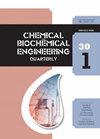Effective Biosorption of Phosphate from Water Using Fe(III)-Loaded Pomegranate Peel
IF 0.9
4区 生物学
Q4 BIOTECHNOLOGY & APPLIED MICROBIOLOGY
引用次数: 0
Abstract
Removal of phosphate from wastewater is necessary for the safety of public health and environmental protection. The present study used an easily available and affordable biosorbent obtained from the pomegranate peel for the excision of phosphate from water. The biosorption behavior of raw pomegranate peel powder (RPGPP) was found negligible. The RPGPP was further saponified with Ca(OH) 2 followed by Fe(III) loading to obtain Fe(III)-loaded pomegranate peels (Fe(III)-PGPP), which was then employed for the phosphate uptake. Fourier transform infrared spectroscopy (FTIR), energy dispersive X-ray (EDX) spectroscopy, scanning electron microscopy (SEM), and X-ray diffraction (XRD) were used to characterize the biosorbent. The batch adsorption test was used to evaluate the adsorption viability of biosorbents for removing phosphate from aqueous solution. Fe(III)-PGPP was determined to have a pH PZC of 5.40. The experimental data were best explained by the Langmuir isotherm and pseudo-second-order kinetic model. Fe(III)-PGPP had the largest phosphate biosorption capacity of 99.30 mg g –1 at the opti-mum pH of 3.0 and 2.5 hours of contact time. From the results obtained, Fe(III)-PGPP adsorbent can be regarded as an effective and cost-efficient material for the treatment of phosphate-anion-contaminated water.负载铁(III)的石榴皮对水中磷酸盐的有效生物吸附
为了公众健康和环境保护的安全,从废水中去除磷酸盐是必要的。本研究使用了一种从石榴皮中获得的易于获得且价格合理的生物吸附剂来去除水中的磷酸盐。生石榴皮粉的生物吸附行为可以忽略不计。将RPGPP与Ca(OH)2进一步皂化,然后负载Fe(III),以获得负载Fe(Ⅲ)的石榴皮(Fe(III)-PGPP),然后将其用于磷酸盐吸收。利用傅立叶变换红外光谱(FTIR)、能量色散X射线光谱(EDX)、扫描电子显微镜(SEM)和X射线衍射(XRD)对生物吸附剂进行了表征。分批吸附试验用于评价生物吸附剂从水溶液中去除磷酸盐的吸附活性。确定Fe(III)-PGPP具有5.40的pH PZC。实验数据最好用Langmuir等温线和拟二阶动力学模型来解释。Fe(III)-PGPP在最佳pH为3.0和接触时间为2.5小时时具有最大的磷酸盐生物吸附能力,为99.30 mg g–1。从结果来看,Fe(III)-PGPP吸附剂可以被认为是一种有效且经济高效的处理磷酸盐阴离子污染水的材料。
本文章由计算机程序翻译,如有差异,请以英文原文为准。
求助全文
约1分钟内获得全文
求助全文
来源期刊
CiteScore
2.70
自引率
6.70%
发文量
23
审稿时长
>12 weeks
期刊介绍:
The journal provides an international forum for presentation of original papers, reviews and discussions on the latest developments in chemical and biochemical engineering. The scope of the journal is wide and no limitation except relevance to chemical and biochemical engineering is required.
The criteria for the acceptance of papers are originality, quality of work and clarity of style. All papers are subject to reviewing by at least two international experts (blind peer review).
The language of the journal is English. Final versions of the manuscripts are subject to metric (SI units and IUPAC recommendations) and English language reviewing.
Editor and Editorial board make the final decision about acceptance of a manuscript.
Page charges are excluded.

 求助内容:
求助内容: 应助结果提醒方式:
应助结果提醒方式:


